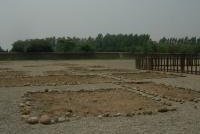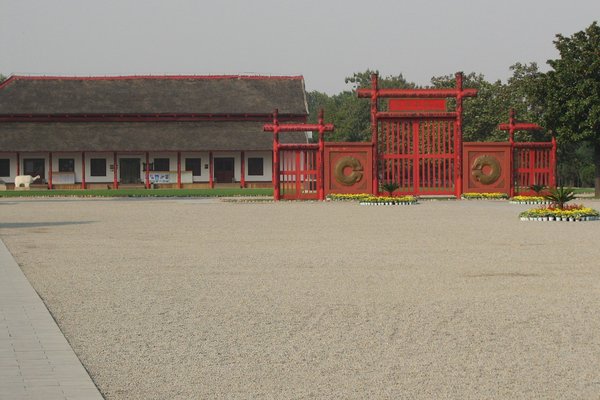China
Yin Xu
Yin Xu is an archaeological site representing the golden age of early Chinese culture, crafts and sciences.
Yin was the last capital of China's Shang Dynasty (1766 BCE to 1050 BCE). It is renowned for the discovery of 'oracle bones', inscriptions on animal bones and tortoise shells which are considered the beginnings of Chinese characters and writing. The tombs also revealed rich bronze ritual vessels, ceramics and chariots in addition to remains of victims of sacrifice.
Community Perspective: “This is an amazing site for those studying the Chinese language”. Els has written a comprehensive review of the various site components that can be visited. Joel reports about the new museum (2024).
Site Info
Official Information
- Full Name
- Yin Xu (ID: 1114)
- Country
- China
- Status
-
Inscribed 2006
Site history
History of Yin Xu
- 2006: Inscribed
- Inscribed
- Type
- Cultural
- Criteria
- ii
- iii
- iv
- vi
Links
- UNESCO
- whc.unesco.org
- Official
-
- ayyx.com — Yin Xu
- Related
-
- china.org.cn — Yin Ruins
All Links
UNESCO.org
- whc.unesco.org — whc.unesco.org/
Official Website
- ayyx.com — Yin Xu
Related Resources
- china.org.cn — Yin Ruins
News Article
- Nov. 7, 2022 english.news.cn — Millennia-old road sheds new light on central China's UNESCO site
- Jan. 7, 2022 globaltimes.cn — 3,000-year-old clan cemetery uncovered in Central China’s Anyang
- Nov. 24, 2020 news.cgtn.com — Central Chinese city builds museum for World Heritage Site ruins
- Sept. 20, 2018 scmp.com — Chinese tomb raiders dug underground tunnels to steal priceless objects from 3,000-year-old Yin Xu royal site
- July 26, 2016 news.xinhuanet.com — Remains of canal found in Yinxu oracle site
- March 5, 2014 ecns.cn — Conflict leads to ruined Yin ruins
Background Wikis
- en.wikipedia.org — Wiki on Oracle bones
Community Information
- Community Category
- Archaeological site: Far Eastern
Travel Information
Luoyang Hotspot
Recent Connections
-
Perfect Inscriptions
2006 -
Memory of the World
Oracle-Bone Inscriptions (2017) -
Luoyang Hotspot
2.5 hours by bus or 40 mins by High Spe…
Connections of Yin Xu
- Trivia
-
-
Former Largest Cities
Around 1300 B.C.
-
- History
-
-
Bronze Age
Chinese Bronze Age -
Famous suicides
King Zhou of the Shang Dynasty of ancient China. Another ruler who killed himself as his kingdom was being taken over. He burnt himself along with his palace. -
Located in a Former Capital
Shang Dynasty (1766 BC - 1050 BC)
-
- World Heritage Process
-
-
Perfect Inscriptions
2006
-
- Human Activity
-
-
Writing systems
Oracle bone script, "the oldest member and ancestor of the Chinese family of scripts" (wiki)See en.wikipedia.org
-
Chariots
Includes Chariots pit of the Shang Dynasty -
Human Sacrifice
"Five of the pits contained the remains of a human sacrifice (four adult males and one child)."See en.wikipedia.org
-
- Constructions
-
-
Tombs
Tomb of Lady Fu Hao -
Dynastic Burial Places
Nine royal tombs from the Late Shang Dynasty (1300-1046 BC) -
Protective Shelters
Archeological sites
-
- WHS on Other Lists
-
-
Memory of the World
Oracle-Bone Inscriptions (2017)
-
- Timeline
-
-
Built in the 2nd Millennium BC
the last capital of China's Shang Dynasty (1300 BC - 1046 BC)
-
- WHS Hotspots
-
-
Luoyang Hotspot
2.5 hours by bus or 40 mins by High Speed Train to Anyang
-
- Science and Technology
-
-
Astronomy and Astrology
Oracle bone inscriptions reveal that the Shang could already record solar and lunar eclipses and star configurations accurately. They also gained a comparatively early understanding of supernova and other astronomical phenomena. (nom file)
-
- WHS Names
-
-
Shortest WHS names
5 letters
-
News
- english.news.cn 11/07/2022
- Millennia-old road sheds new light…
- globaltimes.cn 01/07/2022
- 3,000-year-old clan cemetery uncov…
- news.cgtn.com 11/24/2020
- Central Chinese city builds museum…
Recent Visitors
Visitors of Yin Xu
- Alexander Barabanov
- Alexander Lehmann
- Alex Goh
- Atila Ege
- Bin
- Boj
- chenboada
- Christravelblog
- Dwight Zehuan Xiao
- Els Slots
- Erik Jelinek
- Fan Yibo
- GeorgeIng61
- henryjiao18
- Iain Jackson
- Jeffrey Chai
- Joel on the Road
- Juha Sjoeblom
- jxrocky
- KarenBMoore
- Kasper
- Ken DJ
- Kristin
- lichia
- Luke LOU
- Maciej Gil
- MaYumin
- Miloš Tašković
- nan
- Patrik
- Pchxiao
- Petteri
- Sergio Arjona
- Shandos Cleaver
- Ssong.x
- Szucs Tamas
- Taotao Chen
- trekkie900
- Vincent Cheung
- wantrain.
- Weecheng
- Xander Huang
- Xiong Wei
- Xiquinho Silva
- Yang Chengyu
- Yongcheng Liu
- Zhou Yan
- Zoë Sheng
- Zos M
- ZZSong
Community Reviews
Show full reviews
I’m generally wary of sites in the “something important happened here, but is no longer actually here” category, but Yin Xu was a pleasant surprise. As Els noted in her review, there are two components to this site: the old city, and the royal tombs. But the highlight of this site isn’t actually on the list: the gleaming new museum which had only just opened when we visited in August 2024.
The site is largely focused on the Shang Dynasty, which lasted from approximately 1700-1000 BCE. Most of what we know about the Shang comes from their writing system, inscribed in tiny characters on tortoise shells and other animal bones. It’s considered the birthplace of Chinese writing, and many modern Chinese characters have directly evolved from their Shang equivalents.
We started with the old city, which is still the main dig site and home of the former museum (which is now mostly closed). There were some interesting signs with a surprising amount of English, but the buildings themselves weren’t particularly impressive. Houses and other buildings are laid out with small posts, concrete and bricks, though the use of modern materials made me a little sceptical. One of the buildings had a large pit with multiple chariots, but it wasn’t entirely clear whether they were originals or replicas.
The highlight here was a long series of signs, each showing a Shang dynasty character, what the character meant, what it can tell us about Shang culture, and the modern …
Keep reading 0 comments
From Beijing, it takes 6 hours by train to Anyang - the northernmost city of Henan Province. The trip can be cut short into 3 hours if one takes the fast train or dongche.
To get to Yin Xu from the railway station, one can take bus 28 to Jian Hang (Construction Bank of China) and switch to bus 18 to Yin Xu Park (Yin Xu Bowuyuan).
This is an amazing site for those studying Chinese language - particularly Chinese characters. I have always been fascinated by how they have evolved and seeing the oracle bones museum in the Ancestral Shrines area was such an unforgettable experience for me.
Keep reading 0 comments
The Yin Ruins are spread out over two separate locations: the Royal Palace area and the Royal Cemetery. Arriving at the gate of the Royal Palace area, I hadn't the faintest idea what to expect about this site. But when I saw the gate I immediately felt that this would be a visit to remember. That gate itself is already striking and prepares you for the shapes that you'll see over and over. Behind the gate lies a park with several exhibitions and a museum.
Starting at the museum is a good idea because it tells the story of the people of Yin. That they did practice animal and human sacrifice on a large scale becomes clear immediately. There are many fine bronze objects on display and of course the bones with writing (oracle bones). At first sight, they look just like normal bones, you have to look up really close to see the inscriptions. Amazing! The general feel of the site is brand new and bright, with a lot of attention put into its layout and detailing. There are explanation boards everywhere in English.
One of the highlights in the Royal Palace area is the 'Oracle bones inscriptions stele gallery'. Here, translations from writings on oracle bones into Modern Chinese and English are displayed. What did they write about? Sacrificing, tribute-paying, military actions and astronomy were popular themes. Remarks on good weather and therefore good harvests are also common.
Around the corner, the characters of the …
Keep reading 0 comments
